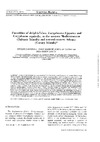Identificador persistente para citar o vincular este elemento:
https://accedacris.ulpgc.es/handle/10553/1061
| Campo DC | Valor | idioma |
|---|---|---|
| dc.contributor.author | Carbonell Baldoví, Enrique | en_US |
| dc.contributor.author | Massutí, Enric | en_US |
| dc.contributor.author | Castro, José Juan | en_US |
| dc.contributor.author | García Murcia, Rosa María | en_US |
| dc.date.accessioned | 2009-10-08T02:31:00Z | - |
| dc.date.accessioned | 2018-03-01T13:45:52Z | - |
| dc.date.available | 2018-03-01T13:45:52Z | - |
| dc.date.issued | 1999 | en_US |
| dc.identifier.issn | 0214-8358 | en_US |
| dc.identifier.other | "856 ; 1787" | - |
| dc.identifier.other | Dialnet | - |
| dc.identifier.uri | https://accedacris.ulpgc.es/handle/10553/1061 | - |
| dc.description.abstract | A total of 648 dolphinfishes were examined for internal and external parasites in western Mediterranean (Balearic lslands) and central-eastern Atlantic (Canary lslands) waters in order to make a comparative study between the two areas. The specimens studied from the Mediterranean Sea was Coryphaena hippurus. with 62 large individuals captured from May to September and 497 juveniles captured from August to December. The specimens studied from the central-eastern Atlantic were 39 adult C hippurus and 49 adult Coryphaena equiselis. Parasites were found in 70% of the fish examined. and represented a total of nine endoparasitic taxa: six.. digeneans (Class Trematoda, Subclass Digenea: Dinurus tornatus. Dinurus breviluctus. Dinurus longisinus. Lecithocladium excisum. Bathycotyle branchialis and Hirudinella sp.). two nematodes ( C lass Nematoda. Order Spirurida; Philometroides sp. and Metabromema magna ) and one acanthocephalan (Phyllum Acanthocephala: Rhadinorhynchus pristis). Seven crustacean copepod ectoparasites were identified: Caligus quadratus. Caligus productus, Caligus bonito. Caligus coryphaenae (Family Caligidae) and Euryphorus nymphae (Family Euriphoridae) were found in gill mucus masses or on the inner surface of the operculum. the lernaeopodid Neobrachiella coryphaenae (Family Lernaeopodidae) was attached to gill filaments and the pennellid Penella filosa (Family Pennellidae) was anchored to fins and rays or. deeply. to muscular tissue and abdominal cavity. The relationships between feeding habits. parasite recruitment and parasite transmission were analysed. sorne ecological aspects of all the parasitic species are discussed. and sorne comments are made on parasite-host relationships. | en_US |
| dc.language | eng | en_US |
| dc.relation.ispartof | Scientia Marina | en_US |
| dc.source | Scientia Marina [ISSN 0214-8358], v. 63 (3-4), p. 343-354 | en_US |
| dc.subject | 3105 Peces y fauna silvestre | en_US |
| dc.subject.other | Lampuga (Peces) | en_US |
| dc.subject.other | Parásitos | en_US |
| dc.subject.other | Canarias | en_US |
| dc.subject.other | Life-History | en_US |
| dc.subject.other | Hemiuridae | en_US |
| dc.subject.other | Morphology | en_US |
| dc.subject.other | Copepoda | en_US |
| dc.subject.other | Digenea | en_US |
| dc.title | Parasitism of dolphinfishes, Coryphaena hippurus and Coryphaena equiselis, in the western Mediterranean (Balearic Islands) and central-eastern Atlantic (Canary Islands) | en_US |
| dc.type | info:eu-repo/semantics/article | en_US |
| dc.type | article | en_US |
| dc.identifier.doi | 10.3989/scimar.1999.63n3-4343 | en_US |
| dc.identifier.scopus | 0033509917 | - |
| dc.identifier.isi | 000084919400016 | - |
| dc.identifier.url | http://dialnet.unirioja.es/servlet/articulo?codigo=2190977 | - |
| dc.contributor.authorscopusid | 7004942011 | - |
| dc.contributor.authorscopusid | 7004259602 | - |
| dc.contributor.authorscopusid | 55976902600 | - |
| dc.contributor.authorscopusid | 55976902600 | - |
| dc.contributor.authorscopusid | 55812813600 | - |
| dc.contributor.authorscopusid | 55812813600 | - |
| dc.identifier.absysnet | 212284 | - |
| dc.identifier.crisid | -;-;1499;- | - |
| dc.description.lastpage | 354 | en_US |
| dc.identifier.issue | 3 | - |
| dc.description.firstpage | 343 | en_US |
| dc.relation.volume | 63 | en_US |
| dc.investigacion | Ciencias | en_US |
| dc.rights.accessrights | info:eu-repo/semantics/openAccess | - |
| dc.type2 | Artículo | en_US |
| dc.contributor.daisngid | 6385147 | - |
| dc.contributor.daisngid | 333011 | - |
| dc.contributor.daisngid | 4843423 | - |
| dc.contributor.daisngid | 8550144 | - |
| dc.identifier.external | "856 ; 1787" | - |
| dc.identifier.external | -;-;1499;- | - |
| dc.contributor.authordialnetid | No ID | - |
| dc.contributor.authordialnetid | No ID | - |
| dc.contributor.authordialnetid | 1771201 | - |
| dc.contributor.authordialnetid | No ID | - |
| dc.identifier.dialnet | 2190977ARTREV | - |
| dc.utils.revision | Sí | en_US |
| dc.contributor.wosstandard | WOS:Carbonell, E | - |
| dc.contributor.wosstandard | WOS:Massuti, E | - |
| dc.contributor.wosstandard | WOS:Castro, JJ | - |
| dc.contributor.wosstandard | WOS:Garcia, RM | - |
| dc.date.coverdate | Enero 1999 | en_US |
| dc.identifier.supplement | -;-;1499;- | - |
| dc.identifier.supplement | -;-;1499;- | - |
| dc.identifier.supplement | -;-;1499;- | - |
| dc.identifier.ulpgc | Sí | en_US |
| dc.contributor.buulpgc | BU-BAS | en_US |
| dc.description.jcr | 0,596 | |
| dc.description.jcrq | Q3 | |
| dc.description.scie | SCIE | |
| item.grantfulltext | open | - |
| item.fulltext | Con texto completo | - |
| crisitem.author.dept | GIR ECOAQUA: Biodiversidad y Conservación | - |
| crisitem.author.dept | IU de Investigación en Acuicultura Sostenible y Ec | - |
| crisitem.author.dept | Departamento de Biología | - |
| crisitem.author.orcid | 0000-0001-9577-5957 | - |
| crisitem.author.parentorg | IU de Investigación en Acuicultura Sostenible y Ec | - |
| crisitem.author.fullName | Castro Hernández, José Juan | - |
| Colección: | Artículos | |
Citas SCOPUSTM
20
actualizado el 08-jun-2025
Citas de WEB OF SCIENCETM
Citations
20
actualizado el 08-jun-2025
Visitas
118
actualizado el 06-ene-2024
Descargas
165
actualizado el 06-ene-2024
Google ScholarTM
Verifica
Altmetric
Comparte
Exporta metadatos
Los elementos en ULPGC accedaCRIS están protegidos por derechos de autor con todos los derechos reservados, a menos que se indique lo contrario.
